Now that travel to Cuba is becoming easier, we wanted to get there before McDonald's. I spent a little time researching the best way and decided a travel agency specializing in getting Americans there was the easiest route. I contacted Cubatodo.com in December; we made reservations for January. To avoid the possibility of weather delays, we flew Portland to L.A. to Miami, then a 45-minute charter to Havana.
We arrived January 14 after dark, were picked up at the airport and driven to Casa Telefonica, a small hotel in Habana Vieja, where was made, according to the plaque on the wall, the first telephone call in Spanish in the world.
More important to us, it was located in the middle of Old Havana, two short blocks from Plaza Vieja, where we headed that same evening.
One of our delightful discoveries in Havana was music; almost every bar or restaurant we frequented had musicians, sometimes one or two, sometimes a band, playing to appreciative audiences. At a corner of the plaza we found La Vitrola, a restaurant with umbrella covered tables in the street and walls covered with photos and music-related artifacts.
After midnight we walked back to the Casa.
The next morning, after a breakfast of fresh fruit, omelet, tea and coffee in the Casa, we walked back to the plaza, which was as appealing in daylight as night,
with delightful cat sculptures around the central fountain,
a bronze sculpture by Roberto Fabelo of a naked lady holding a dinner fork riding a giant rooster,
and canon balls marking off areas.
We walked in the rain down fascinating cobblestone streets, canons inserted upright to block vehicles,
until we arrived at the Iglesia y Convento de San Francisco de Asis, completed in 1730,
now housing a museum of religious art,
(with few artifacts, all enclosed in Plexiglas display cases)
and a 40-meter bell tower. Wood stairs led to the top, past openings that let the blowing rain soak us.
Deb rang the bell.
In front of the church stood a life size bronze by José Villa Soberón of El Caballero de París, a mummer who wandered Old Havana for many years.
His real name was José Maria López (lived 1899-1985). Habaneros claim that pulling his beard or finger brings good luck.
Deb is rolling in luck. Many mummers continue the Caballero's tradition throughout Old Havana. One, simulating a bronze, worked an entrance to the church only feet from the actual bronze, remaining stock still until a tourist walked close to take a photo, then asking for payment.
My telephoto caught him unawares.
Another caught a tourist—we were alerted by her surprised scream when he grabbed her and pulled a toy gun.
Some dressed in traditional garb,
Others more imaginatively.
Even pets get into the act. In the case of two cool dogs, their owner stood nearby to dun whatever tourist was attracted enough to try to photograph the pair.
In the plaza, one pooch worked tables on his own.
On a balcony being used to dry laundry, I saw a cat and took a quick snap. A passerby called to the landress who came onto the balcony to demand her peso.
Old Havana is a prime tourist destination for the Western World (with the sole current exception of the United States), and Habaneros work them just like carnies the world over.
We fled Havana for the Parque Nacianal de Viñales, two hours or so southwest of the capital, to see some of the country. Once out of the city, the road was a divided fourlane highway, running through subtropical country of farms and farmsteads, orchards and fields, with the light traffic made up of automobiles, tractors, trucks, tour buses, and the occasional horsecart. Along the way, we visited a reststop as nice as any in Oregon.
The nearby farm boasted a fine tobacco drying barn;
the farmer posed with his ox team.
Deb said they were the cleanest farm animals she had ever petted. I gave him 5 pesos for his photo.
Our first stop within the park was at Cuevas del Indio, a grotto named for the Indian remains found inside, the parking lot crowded with tourists and tour buses but our guide led us to the head of the line and quickly to the stairway leading down.
The cave is four kilometers long, the path lit regularly with electric lights.
About half way through, we came to a river and a pier where we waited for the ferry (twelve passengers, outboard motor) to carry us on.
We rode a short ways upstream while the boatman pointed out formations that sort of resembled tobacco drying, an Indian profile, other sights,
then he turned the boat and headed down stream.
Perhaps most spectacular was the exit, moving from dark to vibrant green.
We drank a cold beer and then drove a bumpy dirt path to a tobacco farm not far away.
Four generations of one family run the farm and one of them demonstrated cigar making and gave us a sample. He told us that the state took 90 percent of the crop, but farmers kept the best leaves.
As he rolled a cigar, he said that 90 to 95 percent of the nicotine was in the leaf's stem; the state cigar makers discarded about 50 percent of the stems, he took out 90 percent so his cigars were less addictive.
In the town of Viñales, we stopped for lunch at a palapa restaurant, lobster with platters of salad, beans, and rice, washed down with Cuban beer and Mexican Coke while we looked out at the local farms and animals.
Viñales has a number of pastel painted cottages, many with rooms to let for tourists who come for the same reason we had,
to see the striking limestone formations, called mogotes (haystacks), scattered across the valley.
We drove to the Horizontes Las Jazmines hotel and its pavilion on a ridge that offered spectacular views.
While we gazed at the formations starting to be obscured by an oncoming storm, we were entertained by an all-woman band.
Mogotes are remnant of a great limestone plateau formed some 160 million years ago that eroded over the eons, leaving hummocks as high as 1000 feet.
Back in Havana, we continued sightseeing, visiting plazas, cathedrals (pictured is the Catedral San Cristóbal de la Habana),
neighborhoods beyond Habana Vieja, the Hotel Nacional, noted for the 1946 meeting of Mafia bosses to discuss carving up Havana, now notable for the trenches, tunnels, and gun emplacements built in the '70s to defend against American invasion.
The cathedral had interesting knockers on every door. Those on doors easily accessible to tourists were muffled.
We visited Parque Almendares, a lovely stretch of ivy covered trees along the rio almendares, unfortunately marred by a great deal of trash and remains of chickens used by Santerías in religious observation.
While we were there, a group of about a dozen, one holding a live chicken, walked past us into the trees. For a moment, I considered following to photograph their ritual. I passed up that opportunity, but not the chance to snap a 1930s Ford that brought other tourists to the park.
Havana is now known for the old American cars still running and we saw a lot, mostly being used as taxis. We caught a ride from the Hotel Nacional in a 1928 Ford,
but while the streets are an old-car buff's dream, the city is not a repository of concours candidates. The nice looking Chevy we took to Viñales was powered by a Mitsubishi engine,
another had a Toyota under the hood, the ride from the Nacional was a Russian Lada. Nevertheless, the cars are a joy to see.
Of course, other forms of transportation are prevalent as well: tricycle trucks
and taxis,
horse carts
and carriages,
but we liked best the coco-taxis, scooped-out Easter eggs on three wheels.
Even kids in Cuba love cars. This father had just unloaded his daughter and her car from the tricycle taxi.
As we walked the streets, we were captivated by many sights: imaginative signs announcing the business within: the Tobacco Museum,
an hotel,
a perfumery
which also had a sign proclaiming its great age.
This was the same business that had lovely copper alembics in the window and the reflection of a couple of familiar travelers.
We found interesting postal boxes set into walls, but do not know if they are still in use.
We found the remaining segment of the city walls. Construction was started in 1674, completed in 1697; further building continued until it attained its final shape in 1797, then beginning just sixty-six years later it was torn down to allow for the city's expansion.
Other walls displayed Cuban art.
We spent an evening at the Buenavista Social Club, a Grammy-winning CD and Academy Award-nominated documentary movie of the 1990s, in Havana now, a band playing '40s and '50s Latin music in a colonial building on a second floor balcony surrounding a courtyard some 30 yards square open to the night sky.
An unusual musical venue, the band playing one corner of the balcony, listeners spread around the opening.
Among the featured performers was Juana Bacallao, a singer famous in the period, born in 1925 and still belting out the songs.
We looked in on La Bodeguita del Medio, a bar and restaurant with claims to the invention of the mojito, purported hangout of many famous artists including Ernest Hemingway,
now a tourist destination so popular we did not try to squirm our way in.
Our last night in Havana we went to El Mesón de la Flota to see a production by Alma Flamenca, an organization dedicated to the preservation of traditional flamenco dancing, and enjoyed perhaps our most satisfying musical evening.
Although A.F. is an international organization, members passed a basket after each set to collect appreciation, as did every musical group we found.
Our stay in Casa Telefonica was made particularly nice because of the friendly staff, made up of the owner, Señor Elvis, his wife and daughter, none of whom spoke English.
On our final day, we had an hour or so before we had to leave for the airport, so we decided to return to Plaza Vieja for a last drink at the Factoria de Plaza Vieja, a brew pub with huge copper vats behind the bar. While we sat with mugs, a young lady stopped beside the table, scribbled on a piece of paper for a minute, then showed us the results.
I asked her how much, and she said "Ten pesos, but anything you would like to give will be fine." She had recently graduated from art school and had a show in a nearby gallery. I gave her 10 pesos, and got my sole souvenir from our trip.
We arrived January 14 after dark, were picked up at the airport and driven to Casa Telefonica, a small hotel in Habana Vieja, where was made, according to the plaque on the wall, the first telephone call in Spanish in the world.
More important to us, it was located in the middle of Old Havana, two short blocks from Plaza Vieja, where we headed that same evening.
One of our delightful discoveries in Havana was music; almost every bar or restaurant we frequented had musicians, sometimes one or two, sometimes a band, playing to appreciative audiences. At a corner of the plaza we found La Vitrola, a restaurant with umbrella covered tables in the street and walls covered with photos and music-related artifacts.
After midnight we walked back to the Casa.
The next morning, after a breakfast of fresh fruit, omelet, tea and coffee in the Casa, we walked back to the plaza, which was as appealing in daylight as night,
with delightful cat sculptures around the central fountain,
a bronze sculpture by Roberto Fabelo of a naked lady holding a dinner fork riding a giant rooster,
and canon balls marking off areas.
We walked in the rain down fascinating cobblestone streets, canons inserted upright to block vehicles,
until we arrived at the Iglesia y Convento de San Francisco de Asis, completed in 1730,
now housing a museum of religious art,
(with few artifacts, all enclosed in Plexiglas display cases)
and a 40-meter bell tower. Wood stairs led to the top, past openings that let the blowing rain soak us.
Deb rang the bell.
In front of the church stood a life size bronze by José Villa Soberón of El Caballero de París, a mummer who wandered Old Havana for many years.
His real name was José Maria López (lived 1899-1985). Habaneros claim that pulling his beard or finger brings good luck.
Deb is rolling in luck. Many mummers continue the Caballero's tradition throughout Old Havana. One, simulating a bronze, worked an entrance to the church only feet from the actual bronze, remaining stock still until a tourist walked close to take a photo, then asking for payment.
My telephoto caught him unawares.
Another caught a tourist—we were alerted by her surprised scream when he grabbed her and pulled a toy gun.
Some dressed in traditional garb,
Others more imaginatively.
Even pets get into the act. In the case of two cool dogs, their owner stood nearby to dun whatever tourist was attracted enough to try to photograph the pair.
In the plaza, one pooch worked tables on his own.
On a balcony being used to dry laundry, I saw a cat and took a quick snap. A passerby called to the landress who came onto the balcony to demand her peso.
Old Havana is a prime tourist destination for the Western World (with the sole current exception of the United States), and Habaneros work them just like carnies the world over.
We fled Havana for the Parque Nacianal de Viñales, two hours or so southwest of the capital, to see some of the country. Once out of the city, the road was a divided fourlane highway, running through subtropical country of farms and farmsteads, orchards and fields, with the light traffic made up of automobiles, tractors, trucks, tour buses, and the occasional horsecart. Along the way, we visited a reststop as nice as any in Oregon.
The nearby farm boasted a fine tobacco drying barn;
the farmer posed with his ox team.
Deb said they were the cleanest farm animals she had ever petted. I gave him 5 pesos for his photo.
Our first stop within the park was at Cuevas del Indio, a grotto named for the Indian remains found inside, the parking lot crowded with tourists and tour buses but our guide led us to the head of the line and quickly to the stairway leading down.
The cave is four kilometers long, the path lit regularly with electric lights.
About half way through, we came to a river and a pier where we waited for the ferry (twelve passengers, outboard motor) to carry us on.
We rode a short ways upstream while the boatman pointed out formations that sort of resembled tobacco drying, an Indian profile, other sights,
then he turned the boat and headed down stream.
Perhaps most spectacular was the exit, moving from dark to vibrant green.
We drank a cold beer and then drove a bumpy dirt path to a tobacco farm not far away.
Four generations of one family run the farm and one of them demonstrated cigar making and gave us a sample. He told us that the state took 90 percent of the crop, but farmers kept the best leaves.
As he rolled a cigar, he said that 90 to 95 percent of the nicotine was in the leaf's stem; the state cigar makers discarded about 50 percent of the stems, he took out 90 percent so his cigars were less addictive.
In the town of Viñales, we stopped for lunch at a palapa restaurant, lobster with platters of salad, beans, and rice, washed down with Cuban beer and Mexican Coke while we looked out at the local farms and animals.
Viñales has a number of pastel painted cottages, many with rooms to let for tourists who come for the same reason we had,
to see the striking limestone formations, called mogotes (haystacks), scattered across the valley.
We drove to the Horizontes Las Jazmines hotel and its pavilion on a ridge that offered spectacular views.
While we gazed at the formations starting to be obscured by an oncoming storm, we were entertained by an all-woman band.
Mogotes are remnant of a great limestone plateau formed some 160 million years ago that eroded over the eons, leaving hummocks as high as 1000 feet.
Back in Havana, we continued sightseeing, visiting plazas, cathedrals (pictured is the Catedral San Cristóbal de la Habana),
neighborhoods beyond Habana Vieja, the Hotel Nacional, noted for the 1946 meeting of Mafia bosses to discuss carving up Havana, now notable for the trenches, tunnels, and gun emplacements built in the '70s to defend against American invasion.
The cathedral had interesting knockers on every door. Those on doors easily accessible to tourists were muffled.
We visited Parque Almendares, a lovely stretch of ivy covered trees along the rio almendares, unfortunately marred by a great deal of trash and remains of chickens used by Santerías in religious observation.
While we were there, a group of about a dozen, one holding a live chicken, walked past us into the trees. For a moment, I considered following to photograph their ritual. I passed up that opportunity, but not the chance to snap a 1930s Ford that brought other tourists to the park.
Havana is now known for the old American cars still running and we saw a lot, mostly being used as taxis. We caught a ride from the Hotel Nacional in a 1928 Ford,
but while the streets are an old-car buff's dream, the city is not a repository of concours candidates. The nice looking Chevy we took to Viñales was powered by a Mitsubishi engine,
another had a Toyota under the hood, the ride from the Nacional was a Russian Lada. Nevertheless, the cars are a joy to see.
Of course, other forms of transportation are prevalent as well: tricycle trucks
and taxis,
horse carts
and carriages,
but we liked best the coco-taxis, scooped-out Easter eggs on three wheels.
Even kids in Cuba love cars. This father had just unloaded his daughter and her car from the tricycle taxi.
As we walked the streets, we were captivated by many sights: imaginative signs announcing the business within: the Tobacco Museum,
an hotel,
a perfumery
which also had a sign proclaiming its great age.
This was the same business that had lovely copper alembics in the window and the reflection of a couple of familiar travelers.
We found interesting postal boxes set into walls, but do not know if they are still in use.
We found the remaining segment of the city walls. Construction was started in 1674, completed in 1697; further building continued until it attained its final shape in 1797, then beginning just sixty-six years later it was torn down to allow for the city's expansion.
Other walls displayed Cuban art.
We spent an evening at the Buenavista Social Club, a Grammy-winning CD and Academy Award-nominated documentary movie of the 1990s, in Havana now, a band playing '40s and '50s Latin music in a colonial building on a second floor balcony surrounding a courtyard some 30 yards square open to the night sky.
An unusual musical venue, the band playing one corner of the balcony, listeners spread around the opening.
Among the featured performers was Juana Bacallao, a singer famous in the period, born in 1925 and still belting out the songs.
We looked in on La Bodeguita del Medio, a bar and restaurant with claims to the invention of the mojito, purported hangout of many famous artists including Ernest Hemingway,
now a tourist destination so popular we did not try to squirm our way in.
Our last night in Havana we went to El Mesón de la Flota to see a production by Alma Flamenca, an organization dedicated to the preservation of traditional flamenco dancing, and enjoyed perhaps our most satisfying musical evening.
Although A.F. is an international organization, members passed a basket after each set to collect appreciation, as did every musical group we found.
Our stay in Casa Telefonica was made particularly nice because of the friendly staff, made up of the owner, Señor Elvis, his wife and daughter, none of whom spoke English.
On our final day, we had an hour or so before we had to leave for the airport, so we decided to return to Plaza Vieja for a last drink at the Factoria de Plaza Vieja, a brew pub with huge copper vats behind the bar. While we sat with mugs, a young lady stopped beside the table, scribbled on a piece of paper for a minute, then showed us the results.
I asked her how much, and she said "Ten pesos, but anything you would like to give will be fine." She had recently graduated from art school and had a show in a nearby gallery. I gave her 10 pesos, and got my sole souvenir from our trip.



































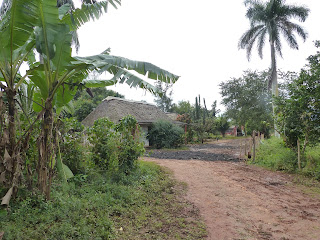

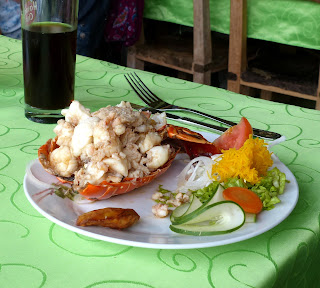















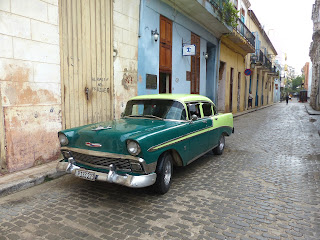





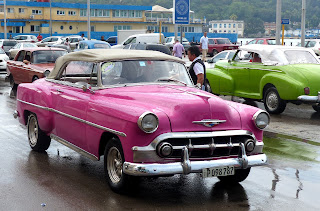












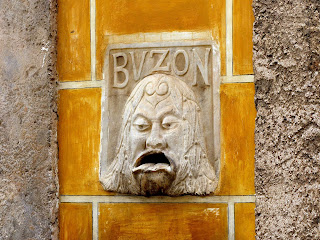













No comments:
Post a Comment